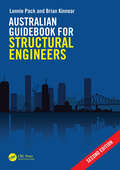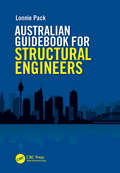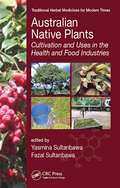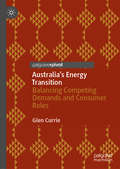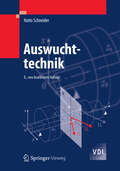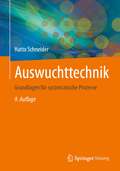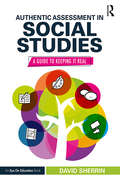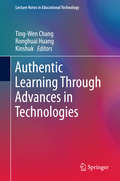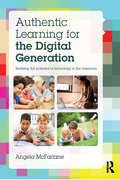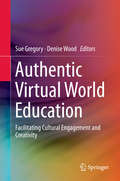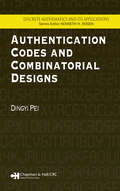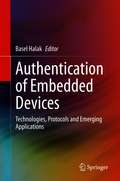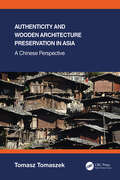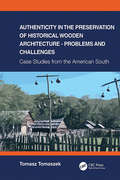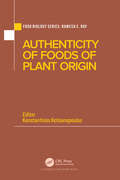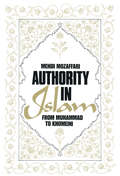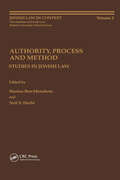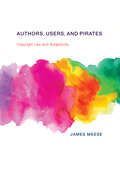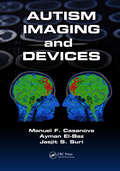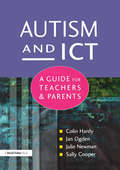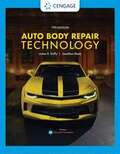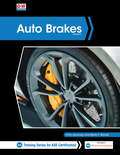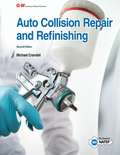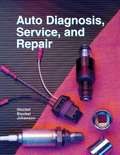- Table View
- List View
Australian Guidebook for Structural Engineers
by Lonnie Pack Brian KinnearThis guidebook is a practical and essential tool covering all the necessary steps for structural design engineers to create detailed and accurate calculations in accordance with Australian and international standards.General project requirements are explained in terms of project management and document control. Calculation methods and details are shown for actions (wind, seismic, dead and live loads). Design details are then provided for steel, concrete, timber, and geotechnical calculations (footings, piles, retaining walls, etc.). Detailed worked example calculations are included throughout the text, as well as typical CAD details for design drawings. Design items are explained for typical items of equipment found across various industries (e.g. piping, vessels, lifting, machine foundations, access, composite structures, bunds, and more). Design aids are provided, including guides and examples for popular engineering programs (Space Gass, Strand7 and Rhinoceros 3D). Comprehensive capacity tables are also included for steel and concrete elements.This edition has been updated to include the latest design requirements from Australian Standards, including Steel Structures (AS 4100–2020), Concrete Structures (AS 3600–2018) (including steel fibre reinforced concrete slabs), Earthquake Actions (AS 1170.4–2024), and basic requirements from Timber Structures (AS 1720.1–2010). Requirements from many more Australian Standards and international standards are also provided in the context of typical design projects.
Australian Guidebook for Structural Engineers
by Lonnie PackThis guidebook is a practical and essential tool providing everything necessary for structural design engineers to create detailed and accurate calculations. Basic information is provided for steel, concrete and geotechnical design in accordance with Australian and international standards. Detailed design items are also provided, especially relevant to the mining and oil and gas industries. Examples include pipe supports, lifting analysis and dynamic machine foundation design. Steel theory is presented with information on fabrication, transportation and costing, along with member, connection, and anchor design. Concrete design includes information on construction costs, as well as detailed calculations ranging from a simple beam design to the manual production of circular column interaction diagrams. For geotechnics, simple guidance is given on the manual production and code compliance of calculations for items such as pad footings, piles, retaining walls, and slabs. Each chapter also includes recommended drafting details to aid in the creation of design drawings. More generally, highly useful aids for design engineers include section calculations and force diagrams. Capacity tables cover real-world items such as various slab thicknesses with a range of reinforcing options, commonly used steel sections, and lifting lug capacities. Calculations are given for wind, seismic, vehicular, piping, and other loads. User guides are included for Space Gass and Strand7, including a non-linear analysis example for lifting lug design. Users are also directed to popular vendor catalogues to acquire commonly used items, such as steel sections, handrails, grating, grouts and lifting devices. This guidebook supports practicing engineers in the development of detailed designs and refinement of their engineering skill and knowledge.
Australian Native Plants: Cultivation and Uses in the Health and Food Industries (Traditional Herbal Medicines for Modern Times)
by Yasmina Sultanbawa and Fazal SultanbawaAustralian Native Plants: Cultivation and Uses in the Health and Food Industries provides a comprehensive overview of native food crops commercially grown in Australia that possess nutritional and health properties largely unknown on a global basis. These native foods have been consumed traditionally, have a unique flavor diversity, offer significant health promoting effects, and contain useful functional properties. Australian native plant foods have also been identified for their promising antioxidant and antimicrobial properties that have considerable commercial potential. This book is divided into three parts: The first part reviews the cultivation and production of many Australian native plants (ANP), including Anise Myrtle, Bush Tomato, Desert Raisin, Davidson’s Plum, Desert Limes, Australian Finger Lime, Kakadu Plum, Lemon Aspen, Lemon Myrtle, Muntries, Native Pepper, Quandong, Riberry, and Wattle Seed. It then examines the food and health applications of ANP and discusses alternative medicines based on aboriginal traditional knowledge and culture, nutritional characteristics, and bioactive compounds in ANP. In addition, it reviews the anti-obesity and anti-inflammatory properties of ANP and discusses food preservation, antimicrobial activity of ANP, and unique flavors from Australian native plants. The third section covers the commercial applications of ANP. It focuses on native Australian plant extracts and cosmetic applications, processing of native plant foods and ingredients, quality changes during packaging, and storage of Australian native herbs. The final few chapters look into the importance of value chains that connect producers and consumers of native plant foods, new market opportunities for Australian indigenous food plants, and the safety of using native foods as ingredients in the health and food sectors.
Australian Precious Opal
by Archie KalokerinosThe magnificent splendour of the Australian opal that has fascinated the world for almost a century is still clad in a mysterious veil of fear and superstition whose only explanation is the lack of knowledge. This book attempts to clear the cloud to some extent to the enjoyment of the readers.
Australia’s Energy Transition: Balancing Competing Demands and Consumer Roles
by Glen CurrieThis book studies Australia, a country characterized by the highest concentration of domestic photovoltaic systems. In addition, the high level of solar energy that Australia receives makes these systems a significant part of its energy mix. International electricity system managers take note; your systems are heading this way. The energy transition is an emerging field, and few texts have been published that can help energy planners as this book does. The research presented is sociotechnical in nature, and reveals that the main challenge in the energy transition is its emerging social role. Very few works combine the social and technical fields of energy. Given its scope, the book will appeal to readers interested in policy, regulation, and energy systems, including government employees involved in energy system management all around the world.
Auswuchttechnik (VDI-Buch)
by Hatto SchneiderFür die Qualitätssicherung von Rotoren ist das Auswuchten ein unverzichtbarer Schritt. Dabei verändern sich mit jeder Weiterentwicklung der Rotoren die Anforderungen an die Auswuchttechnik. Wichtige Prinzipien des Auswuchtens werden in dem Buch erklärt. Es dient als Werkzeug, um die stets neu auftretenden Probleme beim Auswuchten sachgerecht und wirtschaftlich lösen zu können. In der 8. Auflage wird die neue Norm DIN ISO 19499 ausführlich erläutert. Die beabsichtigten Bearbeitungen aller Auswuchtnormen vonseiten des DIN werden erstmals beschrieben.
Auswuchttechnik: Grundlagen für systematische Prozesse
by Hatto SchneiderFür die Qualitätssicherung von Rotoren ist das Auswuchten ein unverzichtbarer Schritt. Dabei verändern sich mit jeder Weiterentwicklung der Rotoren die Anforderungen an die Auswuchttechnik. Wichtige Prinzipien des Auswuchtens werden in dem Buch erklärt. Es dient als Werkzeug, um die stets neu auftretenden Probleme beim Auswuchten sachgerecht und wirtschaftlich lösen zu können. In der 8. Auflage wird die neue Norm DIN ISO 19499 ausführlich erläutert. Die beabsichtigten Bearbeitungen aller Auswuchtnormen vonseiten des DIN werden erstmals beschrieben.
Authentic Assessment in Social Studies: A Guide to Keeping it Real
by David SherrinThis engaging book will show you how to move beyond tests and essay writing to implement authentic assessments in your middle or high school social studies classroom. Award-winning teacher David Sherrin explains the value of authentic assessments and offers practical ways to get started and dive deeper in your own practice. You&’ll be encouraged and inspired by the real-life stories of classroom successes and failures that illustrate the points throughout the book. The chapters cover a range of categories, including different types of written, creative, and civic action assessments. <P><P> The book includes: <li>planning charts and rubrics showing how to use, grade, and give feedback on assessments so they truly aid student learning and progress <li>specific examples, useful tips, and ready-to-go instructions that you can use immediately with your class <li>open-ended assessments encourage scaffolding or adaptation for individual or group work to fit your classroom needs <p><P>You will learn how to personalize instruction and provide students with avenues for creativity and the types of learning experiences they need to be prepared for a complex world.
Authentic Learning Through Advances in Technologies (Lecture Notes in Educational Technology)
by Kinshuk Ronghuai Huang Ting-Wen ChangThis book introduces the advanced technologies used for authentic learning, an educational term that refers to a variety of techniques focusing on how students apply the skills and knowledge acquired in school in real-world situations. In the meanwhile, it presents the latest trends and future developments in learning design, learning environment and assessment for authentic learning using advances in technology, this book discusses how technology supports authentic learning and what makes it effective.
Authentic Learning for the Digital Generation: Realising the potential of technology in the classroom
by Angela McFarlaneWhy should we use technology to support learning? Where does the responsibility lie to prepare young people to be active and successful cybercitizens? Can we go on confiscating pupils’ smartphones indefinitely? Authentic Learning for the Digital Generation is a vital examination of young people’s use of personal devices, online creative communities and digital gaming. It calls into question the idea of the ‘digital native’ and shows clearly that the majority of young users need help and support in order to benefit from the rich learning potential of personal, mobile and online technology use. Written by a leading authority on the role of digital technologies in education, it looks in detail at the practice and implications of learning using personal devices, collaborative online spaces, learning platforms, user generated content and digital games. In particular, approaches to solving problems, building knowledge, manipulating data and creating texts are examined. It offers clear strategies, a vision for what effects on learning we might reasonably expect when children are given access to different types of technology, and explores the challenges of managing these practices in the classroom. Authentic Learning for the Digital Generation offers careful analysis at a time when there is much discussion about young people emerging from school unprepared for the world of work and often struggling to manage their personal relationships as they are exposed to strong content and harsh criticism online. It considers what we know of childhood experience in a digital world and offers ways in which schools and teachers can embrace the opportunity presented by ubiquitous ownership of connected, digital devices to enrich and deepen learning.
Authentic Virtual World Education: Facilitating Cultural Engagement and Creativity
by Sue Gregory Denise WoodThe book presents the possibilities and realities of virtual worlds in education through the application of 3D virtual worlds to support authentic learning, creativity, learner engagement and cultural diversity in higher education. It includes a unique variety of cross disciplinary approaches to research, teaching and learning in a virtual world, including analysis of data from the experiences of students in education, law, Chinese language, sustainability, computer architecture, business, health and the Arts. The book provides unique learning experiences that have celebrated the rich media of virtual world environments through the utilisation of affordances such as simulation, bots, synchronous interaction, machinima and games. The perspectives come from Australia and New Zealand higher education academics but transferable to any higher educational institution in the sector, worldwide, and is significant to various disciplines in the higher education field.
Authentication Codes and Combinatorial Designs (Discrete Mathematics and Its Applications)
by Dingyi PeiResearchers and practitioners of cryptography and information security are constantly challenged to respond to new attacks and threats to information systems. Authentication Codes and Combinatorial Designs presents new findings and original work on perfect authentication codes characterized in terms of combinatorial designs, namely strong partially
Authentication of Embedded Devices: Technologies, Protocols and Emerging Applications
by Basel HalakThis book provides comprehensive coverage of state-of-the-art integrated circuit authentication techniques, including technologies, protocols and emerging applications.The authors first discuss emerging solutions for embedding unforgeable identifies into electronics devices, using techniques such as IC fingerprinting, physically unclonable functions and voltage-over-scaling. Coverage then turns to authentications protocols, with a special focus on resource-constrained devices, first giving an overview of the limitation of existing solutions and then presenting a number of new protocols, which provide better physical security and lower energy dissipation. The third part of the book focuses on emerging security applications for authentication schemes, including securing hardware supply chains, hardware-based device attestation and GPS spoofing attack detection and survival.Provides deep insight into the security threats undermining existing integrated circuit authentication techniques;Includes an in-depth discussion of the emerging technologies used to embed unforgeable identifies into electronics systems;Offers a comprehensive summary of existing authentication protocols and their limitations;Describes state-of-the-art authentication protocols that provide better physical security and more efficient energy consumption;Includes detailed case studies on the emerging applications of IC authentication schemes.
Authenticity and Wooden Architecture Preservation in Asia – a Chinese perspective
by Tomasz TomaszekThe tradition of Chinese wooden architecture dates back to ancient times. The construction solutions developed in this country over the centuries enchant with their refined character, while the historical wooden structures delight future generations with their dignity and aesthetic excellence. China`s wooden architecture, deeply rooted in its spiritual and religious traditions, is undoubtedly the pinnacle of this type of building in Asian culture. At the same time, it is a testimony to the national identity and reflects the specificity of the country`s material heritage. The accelerated social and economic changes in China and the constantly advancing globalization of the world have contributed to this country’s assimilation of Western concepts related to the protection of cultural heritage. The issue of authenticity in the preservation of wooden built heritage proved particularly problematic. This book brings closer the theoretical understanding and practical application of the idea of authenticity from Chinese perspective. To do this, the issue of living heritage and the reception and understanding of traditional Chinese wooden architecture and its preservation as a direct materialization of Chinese religious and philosophical traditions is discussed. The above topics are treated within the cyclic concept of time, i.e. in terms of progress and repetition, with preservation being understood as a religious practice. Finally, trends in the preservation of wooden heritage in present-day China are mentioned, including new attempts to interpret the tradition and the reinvention of the tradition of wooden building. The book aims to contribute to the understanding of the protection of wooden architectural heritage in China from a new perspective, and will be of particular interest to academics and professionals interested in or involved in the preservation of built wooden heritage. ‘(…) a highly valuable contribution to the field of wooden architecture protection and preservation’, Xiaoming Zhu (Tongji University, Shanghai, China) This book ‘(…) successfully explains the inheritance characteristics of Chinese wooden architectures from the perspective of cultural philosophy for a wide audience (…)’, Yasufumi Uekita, University of Tsukuba, Ibaraki, Japan
Authenticity in the Preservation of Historical Wooden Architecture - Problems and Challenges: Case Studies from the American South
by Tomasz TomaszekHistorical wooden architecture is one of the most unique types of heritage built. Built from organic material, wooden buildings remain in harmony with the natural environment and fascinate future generations with its special charm. Because of its uniqueness, wooden buildings reflect the richness of traditional building solutions developed in different parts of the world. At the same time, this type of building contains the spiritual values that were important to those who built these architectural structures. The main topics of 'Authenticity in Preserving Historical Wooden Architecture - Problems and Challenges' are: (i) The method of protection and preservation of wooden buildings as a form of specific historical interpretation; (ii) The question of reconstruction and translocation of a wooden historical building with regard to the level of authenticity; (iii) The analysis of the essence of historical changes and the methods for maintaining and displaying wooden structures in relation to the requirements that determine their historical and architectural authenticity. Showing a variety of aspects of authenticity of wooden buildings, all demonstrated by specific examples (case studies), 'Authenticity in Preserving Historical Wooden Architecture - Problems and Challenges' presents practical implementations of theoretical findings. Hence, the book contributes to the understanding of wooden architectural heritage from a new perspective. The book will be of particular interest to academics and professionals interested in or involved in the preservation of built wooden heritage.
Authenticity of Foods of Plant Origin (Food Biology Series)
by Konstantinos KotsanopoulosFood is adulterated to increase profit or due to negligence. Adulteration can compromise food safety and quality, and harm consumers. This may undermine consumer trust and the reputation of the food industry. As such, it is very important to monitor, control and detect adulteration. A number of techniques have been developed for the authentication of food and verifying its quality and associated claims. Foods of plant origin are the source of nutrients for billions of people around the globe. Due to the huge variety of plants, and the lack of visual characteristics as a result of processing, advanced techniques are required to detect adulteration. This book reviews the latest developments in the field of authenticity of foods of plant origin, examining concepts such as traceability, and how they are applied to facilitate the support of claims, as well as legislative requirements in the major economies around the world. The basic techniques used nowadays in verifying authenticity of these types of foods are reviewed and discussed, and their applications are summarized. The book also focuses on categories of foods most prone to adulteration attempts due to their characteristics, properties and production methods commonly followed, thus allowing the reader to more easily identify the chapter that is of interest in each case. The book will be of interest to food industrialists, chemists, quality control scientists and technologists, microbiologists, analytical chemists and food physical chemists within the food industry. It is also aimed at academicians who are interested in the authenticity of foods of plant origin and the advancements in the analytical fields that support relevant legal and marketing requirements.
Authority in Islam: From Mohammed to Khomeini
by Mehdi MozaffariThis text looks at the future orientation of the People's Liberation Army. It covers military leadership, readiness and expenditure, defense doctrine, high-tech warfare acquisitions, the scientific and technological base for defense procurement and China's security concerns in Northeast Asia.
Authority, Process and Method (Jewish Law in Context)
by Hanina Ben-Menahem Neil S. HechtThe articles in this volume were originally published in Hebrew in Shenaton Hamishpat Haivri and address Jewish law, both in its own context and in the context of contemporary jurisprudence. Contributions range from discussion of the rabbincal court to the doctrine of binding precedent, and from the basis of judicial authority to the legal defence
Authors, Users, and Pirates: Copyright Law and Subjectivity (The Information Society Series)
by James MeeseAn examination of subjectivity in copyright law, analyzing authors, users, and pirates through a relational framework.In current debates over copyright law, the author, the user, and the pirate are almost always invoked. Some in the creative industries call for more legal protection for authors; activists and academics promote user rights and user-generated content; and online pirates openly challenge the strict enforcement of copyright law. In this book, James Meese offers a new way to think about these three central subjects of copyright law, proposing a relational framework that encompasses all three. Meese views authors, users, and pirates as interconnected subjects, analyzing them as a relational triad. He argues that addressing the relationships among the three subjects will shed light on how the key conceptual underpinnings of copyright law are justified in practice.Meese presents a series of historical and contemporary examples, from nineteenth-century cases of book abridgement to recent controversies over the reuse of Instagram photos. He not only considers the author, user, and pirate in terms of copyright law, but also explores the experiential element of subjectivity—how people understand and construct their own subjectivity in relation to these three subject positions. Meese maps the emergence of the author, user, and pirate over the first two centuries of copyright's existence; describes how regulation and technological limitations turned people from creators to consumers; considers relational authorship; explores practices in sampling, music licensing, and contemporary art; examines provisions in copyright law for user-generated content; and reimagines the pirate as an innovator.
Autism Imaging and Devices
by Jasjit S. Suri Manuel F. Casanova Ayman El-BazThis book covers state-of-the-art medical image analysis approaches currently pursued in autism research. Chapters cover recent advances in diagnosis using structural neuroimaging. All aspects of imaging are included, such as electrophysiology (EEG, ERP, QEEG, and MEG), postmortem techniques, and advantages and difficulties of depositing/acquiring images in larger databases. The book incorporates 2D, 3D, and 4D imaging and advances scientific research within the broad field of autism imaging.
Autism and ICT: A Guide for Teachers and Parents
by Julie Newman Sally Cooper Colin Hardy Jan OgdenThis book offers a practical approach for staff and carers who want to develop the use of ICT for children on the autistic spectrum and for those with language and communication difficulties. It combines descriptions of current research and literature on the subject of autism and ICT with practical guidance on software and hardware. A practical approach encourages experimentation, values the skills and attributes that participants bring and minimizes the technical barrier to ICT use. It includes concise information on what autism is, and examples of a range of pupils and their typical learning behaviors. It offers advice on how ICT can relate to various aspects of autism, information on concept keyboards and touch-sensitive screens and switches, and help with buying a computer and using the internet. Teachers, carers and parents of children with autism or language and communication problems will find lots of useful suggestions and advice on how to use ICT to help access the curriculum.
Auto Brakes
by Chris Johanson and Martin T. StockelAuto Brakes presents design, operation, diagnosis, and service information to prepare students for on-the-job success. Brake system operation is fully explained before troubleshooting, service, and repair are discussed. Chapters on anti-lock brakes and traction control describe the operation, inspection, troubleshooting, and repair of these important systems. Scan tool use and trouble code retrieval for diagnosis is also covered. This text is a valuable resource for anyone who needs a thorough understanding of today’s brake systems, including those preparing for ASE Certification Test A5, Brakes.
Auto Diagnosis, Service, and Repair
by Chris Johanson Martin W. Stockel Martin T. StockelAuto Diagnosis, Service, and Repair is intended for beginners who need to learn the fundamentals of automotive repair, as well as persons now in automotive work who want to improve skills and increase earning potential. It also serves as a training aid for those preparing to take ASE certification tests.
